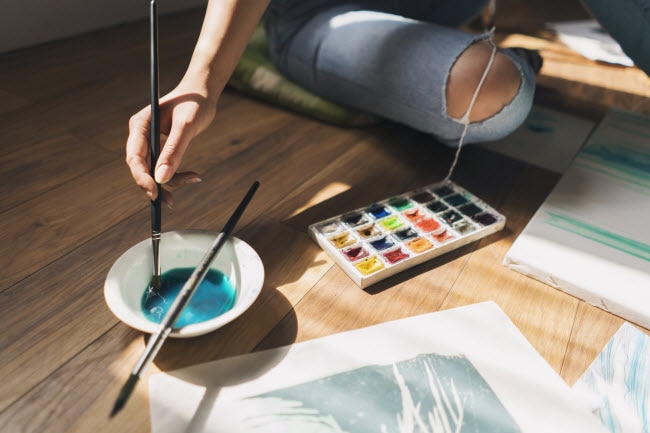Art therapy is a healing modality that pairs creative art making with psychological theories and techniques.
Using art in therapy sessions helps you process painful experiences, uncover negative beliefs and delve deeper into your emotions in a soothing, non-threatening way.
You can take the benefits of art therapy into your own home with a few tips and tools.
Make art creation about the process, not the outcome. Free your body and mind while you’re creating and don’t worry about the result. The looser you are with your art making, the more therapeutic the experience.
Get introspective. Become comfortable with taking a look inside. Trust your instincts and your own emotional regenerative power.
1. Keep an emotional art journal
A journal isn’t just words on a page, it can be so much more. By combining written word, drawing, painting and collage, you can create a contemplative experience that focuses on emotional self-care. Start a daily practice of journaling and use it to process your feelings surrounding issues, stressful situations, interactions and everyday experiences.
2. Paint your feelings
Spend some time meditating on a feeling or emotion. Once you’re embodying it, sit down with paints and paper and allow yourself to paint what you’re feeling.
Do this for a variety of different emotions. Reflect on the colors and symbols that show up in your artwork. Ask yourself what meaning they hold. This will help you develop your emotional vocabulary.
3. Weekly check-in
You can also use this technique to take stock of where you are. Once a week sit down to paint whatever comes to you. Then spend a couple minutes figuring out what emotion you were feeling before you started. Write the emotion on the back of your painting. Look over your piece and find the symbols that stand out to you which match the feeling you were having.
Over time you can use these drawings to discover your home emotion. Think of it as your resting emotional state which affects how you deal with what life throws at you. You can also use these works to take stock of the changes that will happen through these exercises.
4. Worries and a happiness collage
Draw something you’re worried about. Enjoy tearing it up. Then grab some glue and use the pieces of your drawing to create a happiness collage.
Getting a worry out on paper is cathartic. Ripping it up is a way to release it into the universe, and then collaging allows for transformation from something you fear to something hopeful that brings you joy.
5. Outside persona and inner self
Take a cardboard box and decorate the outside to represent the face you show the world. On the inside, decorate to show the you that no one else sees. It’s okay if some of the elements on your box don’t feel positive. You might realize that you show the world a façade, or that you keep some challenging things hidden. You are creating a safe space to put all of you.
After you’re done decorating, fill the box with words or images that represent your positive traits.
6. Mantra drawing
Choose a positive phrase that holds meaning for you. Write the mantra on a sheet of paper, then add colors, symbols, designs and magazine cutouts to illustrate the positive feelings it provokes. Hang it somewhere prominent.
7. Make art part of your meditation
Ask any artist; there is a zone of creation and flow you enter when you let go of control. Choose calming colors, put on some relaxing music and lose yourself as you move to the music. Take turns painting with your non-dominant hand or your fingers for an alternative experience.
8. Clay figurines – Your past, present and future
Any time you work with the human figure, it increases your connection with yourself and how you see you in the world. Plus pounding clay is stress relieving and fun!
Create clay pieces that reflect your journey. Make three sculptures of yourself. One as you were at a specific time of your life, one as you are now and one of the evolved you in the future. Allow it to be as abstract or representational as you want.
Pay specific attention to the changes you see in them. Look for symbols of progress. Be proud of the journey you’ve taken and appreciate where you’re going.

